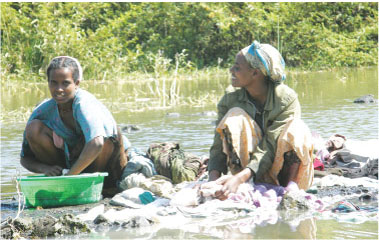3.5.4 Flukes, freshwater snails and schistosomiasis
Rivers, lakes and streams are also essential to the transmission of some species of flukes [flookz] or flatworms, which have flattened ‘leaf-shaped’ bodies. Around 250 million people every year are infected with blood or liver flukes from the genus Schistosoma [shist-oh-soh-mah], so the diseases they cause are called schistosomiasis [shist-oh-soh-myah-siss].
Schistosoma flukes must complete part of their life cycle in freshwater snails, which shed microscopic larvae into the water. When people enter infected water to fish or wash themselves or their clothes (Figure 9), the larvae penetrate the person’s skin along the track of hairs, usually on the legs. The larvae mature into adult flukes (10–16 millimetres long) in the person’s body. Male and female flukes mate and produce eggs with sharp spines that damage blood vessels, mainly in the liver, gut and bladder. Fluke eggs excreted in the faeces and urine of infected people are flushed into water sources in the environment, where they hatch into larvae, which reinfect aquatic snails and the cycle begins all over again.

